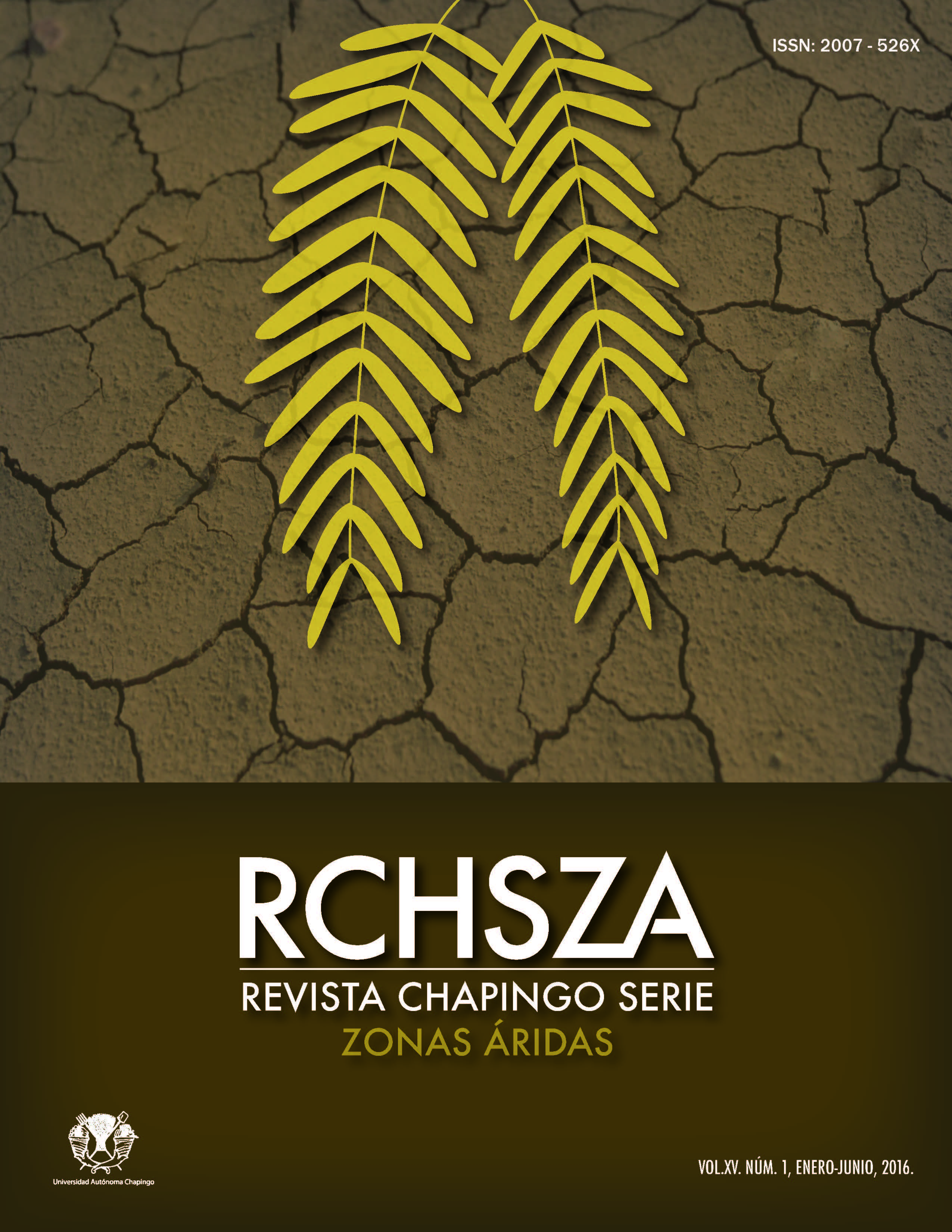Abstract
Samplings of insects associated with huizache were carried out from March to September 2013 in ten huizache trees located at Chapingo Autonomous University’s Drylands Regional University Unit (URUZA), located in Bermejillo, Dgo. A motorized D-Vac model 2846vacuum insect collector and yellow sticky traps were used. The collected material was reviewed under a microscope in the laboratory, finding mostly homopteran insects, particularly adult whitef lies and two groups of parasitoids. Thewhitef ly species affecting huizache was identified as Tetraleurodes acaciae (Quaintance) (Homoptera: Aleyrodidae). The population dynamics of this homopteran was recorded based on adults collected in 20 cm2 yellow sticky traps, with the highest incidence being recorded on July 29 with 359 adults. Percentage parasitism in nymphs was estimated bysampling date, under controlled temperature (28 °C) and relative humidity (30 %) conditions. After 72 hours, emergence was determined, identifying the parasitoids Eretmocerus sp. (Hymenoptera: Aphelinidae) and Signiphora sp. (Hymenoptera: Signiphoridae). The combined percentage parasitism ranged from 0-62 %, with the highest percentage being recorded on September 12. Of the total number of adult parasitoids, 199 individuals belonged to Eretmocerus sp., accounting for 67.2 % of the total, and 97 to Signiphora sp. (32.8 %). This is the first time that the whitef ly T. acaciae has been recorded in huizache in Mexico. Likewise, this is the first verified report of the two identified parasitoids in huizache in Durango, and in the whitef ly T. acaciae.
References
Agekyan, N. G. (1968). Signiphora merceti Malen (Hymenoptera:Chalcidoidea), a parasite of Hemiberlesia rapax (Comst.) in Adzhaira. Entomological Review 47(4), 454-486.
Ávila, G. R., Cano R. P., Nava, C. U., López, R. E., & Sánchez, G. H. (2001). Especies de mosquita blanca presentes en la Comarca Lagunera. Folleto Técnico No 1. Secretaría de Agricultura Ganadería y Desarrollo Rural. Comité Regional de Sanidad Vegetal de la Región Lagunera de Coahuila y Durango. Cd. Lerdo, Dgo. 28 p.
Compere, H. (1936). Notes on the classification of the Aphelinidae with descriptions of new species. University of California Publications in Entomology 6, 277-322.
Comisión Nacional Forestal (CONAFOR). (2015). Acacia farnesiana(L) Wilt. Consultado en http://www.conafor.gob.mx:8080/documentos/docs/13/874Acacia%20farnesiana.pdf.
Comisión Nacional para el Conocimiento y Uso de la Biodiversidad (CONABIO). (2015). Acacia farnesiana(L) Wilt. Consultado en http://www.conabio.gob.mx/conocimiento/info_especies/arboles/doctos/38-legum4m.pdf.
Dozier, H. L. (1932). The identity of certain white f ly parasites of the genus Eretmocerus Hald., with descriptions of new species (Hymenoptera: Aphelininae). Proceedings of the Entomological Society of Washington 34,112-118.
Rodríguez, G. A. (2007). Host plant list of the whitef lies (Aleyrodidae) of the world. Version 070611. USDA/Animal Plant Health Inspection Service (APHIS), 290.
Noyes, J. S. (2005). Universal Chalcidoidea Database. World Web electronic publication. Consultado 03-10-2011 en http://internt.nhm.ac.uk/jdsml/perth/chalcidoids/
Rodríguez-del-Bosque, L. A. (2013). Feeding and survival of Oncideres pustulata (Coleoptera: Cerambycidae) adults on Acacia farnesiana and Leucaena leucocephala(Fabaceae). Southwestern Entomologist, 38(3), 487-497.
Rose, M., & Zolnerowich, G. (1997). Eretmocerus Haldeman (Hymenoptera: Aphelinidae) in the United States, with descriptions of new species attacking Bemisia (tabaci complex) (Homoptera: Aleyrodidae). Proceedings of the Entomological Society of Washington,99 (1), 1-27.
Quezada, J. R., de Bach, P., & Rosen, D. (1973). Biological and taxonomic studies of Signiphoraborinquensis, new species (Hymenoptera:Signiphoridae, a primary parasite of dispine scales. Hilgardia 41(18), 543-604.
Vázquez-Yanes, C., Batis-Muñoz, A. I., Alcocer Silva, M. I., Gual Díaz, M. & Sánchez-Dirzo, C. (1999).Árboles y arbustos potencialmente valiosos para la restauración ecológica y la reforestación.Reporte técnico del proyecto J084. CONABIO - Instituto de Ecología, UNAM.
Woolley, J. B.1997a. Chapter V. Aphelinidae. In Gibson, G. A. P., Huber, J. T., & Woolley, J. B. (editors). Annotated Keys to the Genera of Nearctic Chalcidoidea (Hymenoptera). NRC Research Press, Ottawa, Ontario, Canada. 794 p.
Woolley, J. B. 1997b. Chapter 18. Signiphoridae. In Gibson, G. A. P., Huber, J. T., & Woolley, J. B. (editors). Annotated Keys to the Genera of Nearctic Chalcidoidea (Hymenoptera). NRC Research Press, Ottawa, Ontario, Canada. 794 p

This work is licensed under a Creative Commons Attribution-NonCommercial 4.0 International License.
Copyright (c) 2016 Revista Chapingo Serie Zonas Áridas



